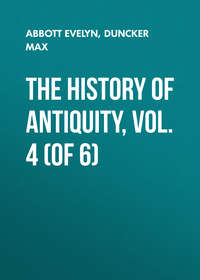 полная версия
полная версияThe History of Antiquity, Vol. 3 (of 6)
The overthrow of Sidon, and the terrible example which Esarhaddon had made by this execution of the conquered princes, appears to have frightened all Syria into obedience. To this, at any rate, the assembling of all the princes of Syria, of which the cylinder speaks, points; and we learn further, without any mention of new contests in Syria, that the princes of Cyprus paid homage to Esarhaddon. After the cylinder has narrated the achievements of Esarhaddon against the Arabs, the Medes, and the Cilicians, which he accomplished down to the close of the year 674 B.C. (the cylinder bears the date of the year of Atarilu i. e. of 673 B.C.), it proceeds to the description of the buildings of Esarhaddon. In Nineveh he built at the smaller edifice of his father to the south of the Khosr, and at the great palace of Sennacherib to the north of it (p. 106). The description of the buildings begins with the mention of an embassy of Esarhaddon to the princes of Syria and Cyprus, and their assembling; they have to provide the material and adornment of these palaces by taxes and contributions. Twelve kings of the Chatti were called upon: Baal, king of Tyre; Manasses, king of Judah (Minasi sar ir Jahudi); Kausgabri, king of Edom; Musuri, king of Moab; Zilli-Bel, king of Gaza; Mitinti, king of Ascalon; Ituzu, king of Ekron; Milkiasap, king of Byblus; Matanbaal, king of Arvad; Abibaal, king of Samaria; Puduil, king of Ammon; Achmilku, king of Ashdod. No mention is made of a prince of Sidon; as the inscriptions told us above, that city was under a viceroy of the king. In addition to these twelve kings, a summons was sent to "ten kings of Yatnan (Cyprus), in the midst of the sea: " Ikistusu (Aegisthus) king of Idalium (Idial); Pisuaguru (Pythagoras), king of Kitrusi (Chytrus?); – , king of Salamis (Sillumi); Ituandar (Eteandros), king of Paphus (Pappa); Iriil (according to another reading Eresu), king of Soli (Sillu); Damasu (Damasus), king of Kurion; Rumisu, king of Tamasus; Damusi, king of Amtihatasti (Amathus?); Unasagusa, king of Limenia (Limini); Buhli, king of Aphrodision (Upridissa). "In all, I called upon 22 kings of the land of the Chatti on the sea coast and in the sea."342
But in spite of this obedience of the princes of Syria and Cyprus, Esarhaddon had to undergo contests in Syria after this time, i. e. after the year 674 B.C., which brought him beyond the borders of Syria. In the year 697 B.C. Manasses succeeded his father Hezekiah in Judah; he was then a boy of 12 years of age.343 But when he came of age he did not follow in the steps of his pious father; therefore, we are told in the Chronicles, Jehovah caused the captains of the army of the king of Assyria to come upon him; they took Manasses prisoner with thorns, and bound him in chains, and carried him to Babel. And when he was in distress he besought Jehovah, and humbled himself before the God of his fathers, and Jehovah heard his prayer, and caused him to return to Jerusalem, to his kingdom.344 The Books of the Hebrews further tell us that Esarhaddon, king of Assyria, settled people from Persia, Erech and Babel, from Susa and Elam, in Samaria.345 The carrying away of Manasses, and strengthening of the foreign population in Israel, can only have been caused by attempts at rebellion in the kingdom of Judah and land of Israel. These attempts must have taken place after 674 B.C., with which year the cylinders close, which narrate the deeds of Esarhaddon down to this point, without any mention of such rebellions; on the contrary, we saw that these cylinders at the close of this epoch describe Manasses of Judah and Abibaal of Samaria as among the obedient and tributary vassals of Esarhaddon. The fragment of an inscription of Esarhaddon, which narrates the events of his tenth campaign, and which we cannot place before the year 673 B.C., as there is no mention of the campaign in the inscriptions dated from that year, informs us of a rebellion of Baal, king of Tyre, who was mentioned at the close of the inscriptions previously quoted at the head of the vassals of Esarhaddon in Syria. We can assume the more certainly that Judah and Samaria joined this rebellion, as the fragment adds: King Baal of Tyre "threw off the yoke of Assyria, trusting in king Tarku (Tirhaka) of Cush."346
It must have been the interference of Egypt, the hope in Egypt and Ethiopia, which urged a portion of the Syrians to renewed attempts at rebellion. Tirhaka, as we have seen, fought against Esarhaddon's father in the year 701 B.C., by no means without success, at Eltekeh; after the battle Sennacherib abandoned Syria. The restoration of the supremacy of Assyria, which took place after the overthrow of Abdimilkut of Sidon, was calculated to drive the ruler of Egypt and Ethiopia to an attempt to prevent the establishment of Assyria on his borders. In the hope of such assistance, Tyre, which stood at the head of Phœnicia, after the defeat of Sidon, may have taken up arms; Judah and Samaria may have joined her. The fragment of another inscription of Esarhaddon tells us that he sent out his forces "to fight against Tarku, the king of Cush, against the men of Egypt, and the allies of Tarku" (i. e. no doubt, against Tyre, Judah and Samaria). The Assyrian army won the victory. Tarku fled.347 The return of Tirhaka was followed by the subjugation of Judah and Samaria, the carrying away of Manasses to Babel (Esarhaddon built, as we saw, at Babel, and then, no doubt, resided there), and the settlement of inhabitants from the East in Samaria, in order to secure the obedience of this land. We may put these events in the year 673 B.C. As Tyre on her island continued her resistance, Esarhaddon marched to break this down, on his tenth campaign, in the early spring, in the month of Nisan, crossed the swollen waters of the Euphrates and Tigris, caused fortifications to be thrown up against Tyre, cut them off, as he says, from water and food, and directed his march against Muzur (Egypt) and Miluhhi (Napata). From Aphek in Samaria he set out southwards against Raphia (Refah near Gaza), where his grandfather Sargon had defeated Sabakon (Seveh) of Ethiopia and Egypt nearly 50 years before (p. 88). On the march through the desert the army suffered from want of water; but Merodach came to the aid of Esarhaddon's warriors, and saved their lives, – as the inscription tells us, which breaks off at the point where it is telling of the first conflict with the enemy. After the indubitable successes of Esarhaddon against Tirhaka, Tyre submitted: the king Baal was pardoned; we find him again at the head of the city under Esarhaddon's successor. In the same way, after the subjection of Tyre, or some time later, when no one in Syria could any longer found hopes on Egypt, Manasses again became king of Judah, as the Hebrews state. In the list of the subject princes of Syria after the death of Esarhaddon, the king of Judah follows immediately after Baal of Tyre; unfortunately the name (in any case Manasses) is broken off.
Either on the campaign, of which the first incidents have been already related in the fragment last mentioned, or on a campaign immediately following, Tirhaka was not only defeated, but driven out of Egypt, back to his own native land. Esarhaddon became lord of Egypt. A fragment of Abydenus says: "Esarhaddon obtained the lower portions of Syria and Egypt by conquering them."348 On that rock of the Phenician coast at the mouth of the Nahr el Kelb, between Byblus and Berytus, where Sennacherib had caused his picture and inscription to be engraved beside the sculptures of Ramses II., Esarhaddon also caused his image to be engraved, after he had become master of Egypt. In its damaged condition the inscription only allows us to ascertain that victories over Tirhaka, the capture of Memphis, the conquest of Egypt, are mentioned in them. At the close the inscription speaks of Tyre, and again mentions 22 kings, i. e. it records the second complete submission of Syria.349 Esarhaddon's successor informs us: his father had marched to Egypt, and forced his way to the midst of Egypt. "He defeated Tirhaka, the king of Cush, and destroyed his power. He conquered Egypt (Muzur) and Cush, and carried away innumerable prisoners. He subjugated the land throughout its whole extent, and annexed it to Assyria. The earlier names of the cities he altered, and gave them new names; his servants and viceroys he entrusted with the dominion over them; the payment of tribute he imposed upon them."350 The list of the 20 viceroys or princes which Esarhaddon placed over Egypt after the expulsion of Tirhaka, allows us to see that the greater number of the reigning families in the districts of Egypt, who had maintained themselves under the dominion of the Ethiopians, must have recognised the dominion of Esarhaddon in the place of the dominion of Tirhaka, and passed from vassalage to him into vassalage to Assyria. But not all. Many of them may have shared Tirhaka's fortunes. In the place of those who did not adapt themselves to the new rule, came others who thought to rise as adherents of Assyria. The prince who received from Esarhaddon the regions of Sais and Memphis, and consequently the most important position, Niku (Necho), was certainly a man who had vigorously supported the new government.351 Sarludari is said to have governed the canton of Zitinu; Pakruru, the land of Pisaptu; Putubasti, the land of Tanis (Zanu, Zoan); Harsiesu administered the land of Zabnuti (Sebennytus); Tapnachti (Tnephachtus), the canton of Bunubu; Sushinqu, the land of Busiris (Pusiru); Ziha, the land of Siut; Lamintu, the land of Chimuni; Ispimatu, the land of Taini (Thinis); Muntimianche, the land of Thebes (Niha).352 According to this, Esarhaddon made those princes of the districts in Egypt who, though they had hitherto obeyed Tirhaka, were willing to submit to him, his vassals, so far as he did not replace them by Egyptians, whom he considered more trustworthy, and here and there by Assyrians. To Necho he handed over or continued the important districts of Memphis and Sais. As Necho of Sais came to the throne, according to the statement of Manetho, eight years before Psammetichus, and Psammetichus, according to the date of the Egyptians, became king in 664 B.C., Necho's accession falls in 672 B.C., and the conquest of Egypt by Esarhaddon may be placed in this year. The conquest of Cush, i. e. of the land of the South, is due to the exaggeration of Esarhaddon: we find Tirhaka soon after in possession of Napata. The slabs of reliefs which Esarhaddon caused to be made for the adornment of the new palace which he began to build at Chalah after the conquest of Egypt, bear on the reverse the inscription: "Palace of Esarhaddon, king of Asshur and Babel, king of Muzur (Lower Egypt), king of Patrus (Patores, Upper Egypt), of the land of Miluhhi (Meroe), and of the land of Cush."353
This new palace at Chalah was built by Esarhaddon in the south-west corner of the terrace on which rise the royal fortresses of this city, to the west of the building of Tiglath Pilesar II. In extent it comes nearest to the palace of Assurnasirpal in the north-west corner (II. 311). But it was not completed, though Esarhaddon did not hesitate to take the reliefs from the palace of Tiglath Pilesar and use them for his new building (p. 14). A broad staircase leads to the south front, to a double portico guarded by lions and sphinxes. The sphinxes are recumbent lion-bodies, with wings; the human head bears the Assyrian tiara surrounded by horns. These forms, not elsewhere found in Syria, prove a certain imitation of Egyptian models, which the Assyrians must have become first acquainted with on the Nile.354
CHAPTER VIII.
ASSURBANIPAL'S WARS AND VICTORIES
In his last years Esarhaddon had raised his son Assurbanipal to be co-regent with himself.355 Shortly before his death, which overtook him in the year 668 B.C. after a short but eventful reign of 13 years, he appears to have given up the government entirely to him.356 Immediately after his accession the new prince received the intelligence that Tirhaka, whom his father had driven out of Egypt into Napata, had invaded Egypt, and taken Memphis, that the princes whom Esarhaddon had entrusted with the government of Egypt had fled before Tirhaka into the desert.357 Assurbanipal collected his army in order to maintain Egypt. In Syria he received the homage of the princes of that land and of Cyprus, who had brought tribute and had been subject to his father. These were the lords of the states mentioned in the inscriptions of Esarhaddon, – the princes of Tyre, Judah, Edom, Moab, Gaza, Ascalon, Ekron, Byblus, Arvad; with the exception of Baal of Tyre (p. 156), their names are broken out of the inscription (Cylinder C); the three last states of Syria, found in the list of Esarhaddon, Samaria, Ammon, and Ashdod, are also wanting here. Then follow the kings of Cyprus, in which the cities and the persons are those of the list of Esarhaddon; only the three first are wanting. But as the whole number is again put at 22 princes of the land of the coast and the sea, we may conclude with certainty that from the year 672 B.C. – since the rebellion and re-installation of Baal of Tyre, and Manasses of Judah, there had been no movements and changes in Syria.
Assurbanipal informs us that he went down from Syria to Egypt; at Karbanit he met the army of Tirhaka, and drove it out of the field. When Tirhaka heard of this at Memphis, he retired to Thebes. Assurbanipal pursued him, took the city, and caused his army to encamp in it; he restored the 20 princes to whom his father had given the districts of Egypt, left behind a portion of his army, and returned to Nineveh with rich booty (668 B.C.).358 Tirhaka was again forced back to Napata,359 but the dominion of Assyria was not yet firmly established in Egypt. Assurbanipal may have imposed heavier duties on the rulers of the districts; the continued stay of Assyrian troops in Egypt may have appeared too burdensome and oppressive. Whatever the motive, some of these vassals entered into secret communication with Tirhaka; at their head was Necho, the chief of the most important districts, Memphis and Sais, and with him Sarludari of Zihinu, and Pakruru of Pisaptu. They intended to return from the vassalage of Assyria to the vassalage of Napata; they invited Tirhaka to return to Egypt and again seize the sovereign power. The condition would without doubt be that Tirhaka should continue them in their rule over the cities and districts which Esarhaddon and Assurbanipal had given over to them. But the leaders of the Assyrian troops captured their messenger, caused Necho, Sarludari, and Pakruru to be arrested, put them in chains, and sent them to Nineveh. The Assyrians took Memphis, Mendes (Ben-didi), and Tanis (Zanu, Zoan), cut down the inhabitants who resisted, and broke the towers on their walls. Tirhaka retired before the Assyrian troops to Napata.
It appears that Assurbanipal attempted to give other supports than mere force of arms to his rule over the distant Egypt. He released Necho from his bonds, restored to him the government of Sais, and gave to his son Neboshezban the government of the canton of Athribis: "I continued to extend to them," he tells us, "the kindness and favour which my father had shown them." Even these means were soon found to be insufficient. Tirhaka's days came to an end. He was succeeded on the throne of Napata by Urdamane, whom Assurbanipal calls a son of Sabakon (Sabaku). He set out to restore the dominion of Ethiopia over Egypt; he won Thebes, defeated the Assyrian troops before Memphis, shut up the defeated army in Memphis, and took them prisoners. "A messenger went in haste to Nineveh" to bring to the king the intelligence of these grievous disasters.360
Assurbanipal set out for Egypt in person, to make good the blow which the arms of Assyria had received, to restore the prestige and dread of his power. When he had crossed the borders of Egypt, Urdamane left Memphis in order to return to Thebes. "The princes and viceroys whom I had placed over Egypt, came before my face and kissed my feet," so Assurbanipal tells us. "I pursued Urdamane and came to Thebes; he fled at the approach of my mighty army. I took the city of Thebes; silver, gold, precious stones, the treasures of the palace, men and women, two great obelisks, which stood before the gates of the temple, engraved with beautiful sculptures; a great and innumerable booty I carried away from Thebes (Niha) to Assyria. I made my warriors march over Egypt and Cush, and won glory."361 "No-Ammon (Thebes) was situate among the rivers," – so the prophet Nahum describes the capture and desolation of Thebes by Assurbanipal and the Assyrians, – "with waters round about her, whose rampart was the stream, and her walls the stream. Ethiopia (Cush) mighty in numbers, and Egyptians endless in multitude, Phut (Arabians) and Libyans (Lubim) were her helpers. Yet she went forth into misery and captivity; her children were dashed to pieces at the tops of all the streets. They cast lots for her honourable men, and all her great men were bound in chains."362
The repeated attempts of Tirhaka and his successor to re-establish the government over Egypt from Napata were wrecked. After the capture and sack of Thebes, which we can place in the year 663 B.C.,363 Assurbanipal sought further to secure the obedience of Egypt by settlers, whom he brought there from conquered lands.364 From that time, for at least ten years, Egypt remained in his possession without any disturbance. But in spite of this establishment of the Assyrian dominion in Egypt Assurbanipal had again, in the next few years, to quell rebellions in Syria. Tyre and Aradus attempted to regain their independence, an attempt at defection, which could now have even a less chance of success than when Egypt stood unbroken under the Ethiopians. Baal, king of Tyre, who had already rebelled against Esarhaddon, and was afterwards pardoned and restored, who subsequently paid his tribute with all obedience, now took up arms anew, ten years after his first rebellion. Assurbanipal's third war was directed against Tyre and Aradus. He tells us that the fortresses of king Baal were taken, that he cut off all exit from Tyre, and compelled the inhabitants to drink the water of the sea, that he brought about their submission by a close investment. When Baal had given up his son, his daughters, and the daughters of his brothers, with a considerable tribute, he was again replaced in his dominion.365 The king of Arvad, also Yakinlu, "who dwelt in the sea" (the city of Arvad lay on an island off the coast, II. 277), was compelled to submit; he sent his daughter with many presents to Nineveh for the harem of the king, and kissed Assurbanipal's feet; after his death the government of Arvad was entrusted to Azibaal, a son of Yakinlu.
Assurbanipal's power and supremacy reached far to the west beyond Syria. He tells us that Mugallu, the king of the Tibarenes, and Sandasarmi of Cilicia, who had not obeyed his predecessors, sent their daughters to Nineveh, and kissed his feet. Gyges (Gugu) also, the king of Lydia, "a land, the name of which my father had not heard," says Assurbanipal, sent a message to Nineveh. Gyges had obtained the throne of Lydia by violence; he was opposed by a strong party who adhered to the old royal family which he had overthrown; and it was not in domestic matters only that he found himself in difficulties. The Cimmerians who had invaded Asia Minor and were settled there on the lower Halys, who, as Esarhaddon told us, recognised his supremacy (p. 151), had forced their way from thence to Phrygia and Lydia. Gyges obviously sought support in Assyria, the strong neighbour of the Cimmerians, as soon as and as long as Tubal and Cilicia obeyed the king of Asshur. The inscriptions of Assurbanipal tell us that Gyges promised obedience to him and brought tribute.366 Thus the supremacy of Assyria reached the west of Asia Minor, the coasts of the Ægean Sea (about 660 B.C.).
The next campaigns of the king were directed to the north. Achsheri, king of Minni, had kept back his tribute. The Assyrians traversed and desolated his land in two successive invasions; Achsheri's own subjects rose against him, and slew him; his son Ualli submitted, sent his daughter to Nineveh, and paid the tribute which had been kept back, and which Assurbanipal increased by 30 horses.367 Sarduri, king of the neighbouring Ararat (Urarti), sent rich presents, and acknowledged the supremacy of Assyria. The rebellion of Birizchadri, a chief of the Medes, and of the two sons of Gagi, a chief of the Sacae (Sachi), Sariti and Pariza was defeated; 75 fortified places were taken; the three rebels were taken prisoners and carried to Nineveh.368
Assurbanipal bestowed especial attention on Babylonia, the government of which he had entrusted to his younger brother Samul-sum-ukin (Samuges in Abydenus, Saosduchinus in the canon of Ptolemy).369 He tells us that here also he had continued the building of the temples which his father had begun, that he built at Bit Saggatu at Babel, and erected four silver bulls at the gate of the temple of Bit Zida at Borsippa, that he had adorned the abodes of Bel and Bilit. A brick found at Babylon bears the inscription, "to the god Merodach, my lord, Assurbanipal, king of Assyria, king of Babylon."370 When Urtaki, king of Elam (he had succeeded his brother Ummanaldas I. on the throne there), invaded Babylonia, Samul-sum-ukin called on his brother for assistance; the Elamites were already encamped before the walls of Babylon.371 "To protect Bel and Nebo, my gods, whom I served," says Assurbanipal, "I gathered together my warriors." The Elamites were driven back to their borders. Not long after this failure Urtaki, king of Elam, died, and the third brother of Ummanaldas and Urtaki, Teumman, ascended the throne. The sons of the two elder brothers, the sons of Ummanaldas, and the sons of Urtaki (the latter were called Ummanigas and Tammaritu) were afraid that Teumman would cause them to be removed out of his way, in order to secure the succession for his own sons, and fled to Assyria.372 Teumman demanded that they should be given up. Assurbanipal refused; and when in consequence Teumman declared war and invaded Assyria, Assurbanipal sacrificed to the war-goddess Istar at her abode in Arbela, "the city of the joy of her heart," and prayed: "O thou goddess of goddesses, dreadful in battle, goddess of war, queen of the gods, rejoice the heart of Asshur; strike down Teumman and destroy him. And the goddess heard my prayer and said: Fear not; I will grant thee favour." But in that night Istar appeared in a dream to the seer, with her bow in her hand, and announced that the enemy would not remain; in the midst of the battle she would protect the king of Asshur.373 Assurbanipal went against Elam in his fifth war, which he led in person. Teumman retired before the Assyrians, and awaited the attack of their army in a position at Eulæus (Ulai), in the neighbourhood of Susa. The Assyrians, and with them the sons of Urtaki, Ummanigas and Tammaritu, fought with success. Teumman, wounded in the battle, fled with his eldest son; the chariot broke down in the forest; they were taken and slain. Assurbanipal placed Ummanigas on the throne of Susa. A relief in the palace of Assurbanipal depicts the enthronement of Ummanigas at Madaktu and Susa by an Assyrian officer.374 Chidalu, a part of Elam, which hitherto had been ruled over by Istar-Nandi – the East of Elam apparently – was handed over to Tammaritu. Teumman's head was seen at the entrance of Assurbanipal into Nineveh: it was placed on the great gate of that city (about 655 B.C.).375
Assurbanipal had carried off one success upon another; he was master of Egypt, received tribute from Lydia, and placed kings over Elam at his pleasure, when the rebellion of his brother Samul-sum-ukin in Babylon threatened to overthrow the foundations of the kingdom. Eager to reign independently, Samul-sum-ukin opened the treasures of the temples of Bel at Babylon, of Nebo at Borsippa, of Nergal at Kutha, and sent rich presents to Ummanigas, whom Assurbanipal had raised to the throne of Elam not long before, in order to incite him to take up arms against Assyria and to secure the aid of Elam. Ummanigas took his side.376 Samul-sum-ukin also called on the districts on the Euphrates and Tigris to join him. In vain did the prefects of Erech, Amida, and Arapha attempt to check the rebellion. The children of Babylon forgot the favour shown to them, says Assurbanipal, the temples which he had restored and adorned with silver and gold; the inhabitants of Sippara, Babylon, Borsippa, Kutha disregarded their brotherhood, and took up arms against him. The signal given by the king's own brother was followed by the Arabians, Syrians, and Lydians. "That faithless brother, Samul-sum-ukin, led astray the inhabitants of Accad, of Chaldæa, of Aram, and of the sea coast, my tributary subjects, to rebel against me. The princes (sarri) of the land of Guti, of the land of the West (mat acharri), of Miluhhi, which my hands brought into submission, all these he seduced to fall from me, they took his side: " such is the statement of Assurbanipal.377








